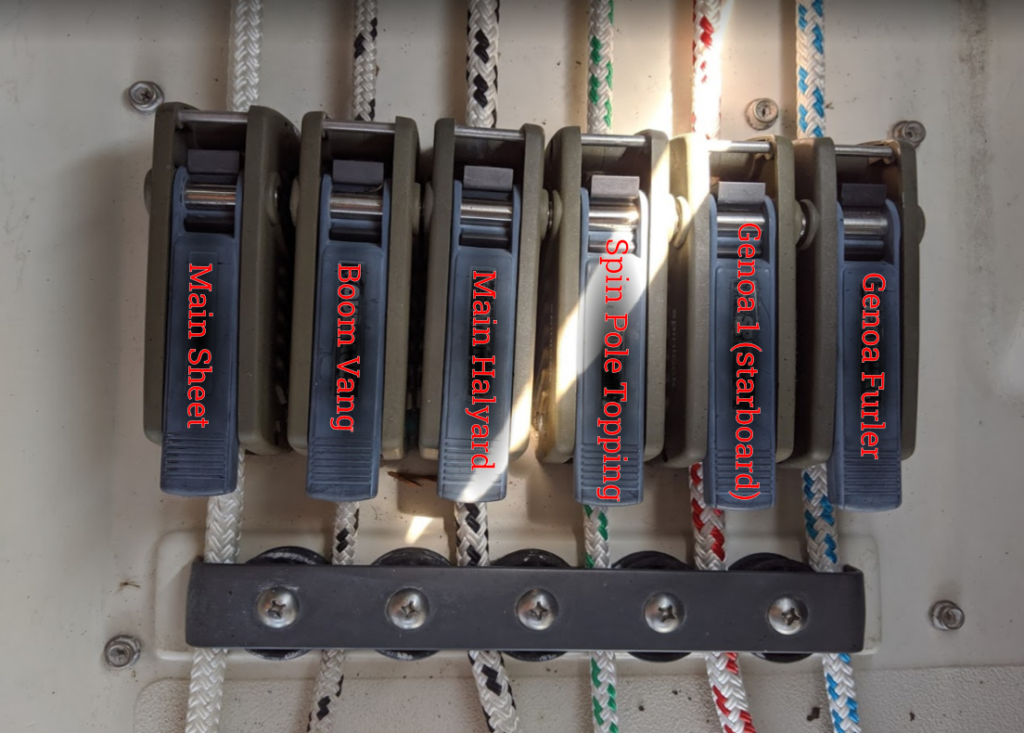CS34 Running Rigging
Now in our second year with our new lines I believe we finally have a decent setup for our running rigging. Here’s how we have it setup on our boat.
Starboard

I believe these are the default setup. The lines are following the labels on the mast. Only change I did was the two separate blocks for the boom vang and the main sheet. The original setup had a double block, but the angles of the lines coming from the boom were not exactly parallel causing one line to roll on the side of the block.
Previous owner had the genoa furler running down separate blocks down the port rail. I prefer this method since it puts the furling line next to all the other lines in the cockpit through a clutch and can use a winch if needed. It does interfere with the forward hatch, but it’s easy to flip it out of the way when opening or closing the hatch.

I don’t like the fact that the boom vang and the main halyard are using the same colour of line. It’s a short line, I’ll eventually replace. The genoa 1 is running to our furling genoa and I like the red for “do not touch”. My son once accidentally released this line during our Waupoos to Kingston trip.
Port

The reefing lines are going to our boom and took me a bit to figure out. I should get some more pictures to explain this. On leech (stern) of sail these lines go through the sail and back down to the boom. On the luff (bow) of the sail these lines come out of the boom, go down to the block and then up to the sail and secured with a stopper knot. Chose green for first reef as “safety” and red for second reef as “danger”.
The outhaul is our only dynema line, chose this because I replaced the existing line that was spliced with a steel cable in our boom. The topping lift and the genoa 2 lines follow the labels on the side of the mast. The baby stay runs up to the block on our deck. I’ve never really used this. I’ve been told it’s only for securing the mast and preventing excessive bend in heavy winds.

Genoa sheets
These run from the clew of the genoa down both sides of the boat (inside the lifelines) to the track and then through the block on the deck near the winch to the winch.
If I’m running downwind, I set the block in the track more towards the bow if I’m running upwind I set the block more towards the stern.
Where we bought our lines
I have a separate blog post on this, with suppliers and lengths of rope here: Brand new lines
Spinlock clutches
The CS34 came with 12 Spinlock XA clutches. They can accommodate 6mm – 12mm (1/4″ – 1/2″) lines. They require little maintenance, Lewmar suggests:
- flush regularly with fresh water and lubricate handle / cam bearing with silicone grease or spray
- Do not use mineral oil & solvent based lubricants like “WD40” which will accelerate the aging of plastic components
- Reseal to dock using Silicone rubber sealant or use the neoprene installation gasket (XA-GA50), Do not use polysulphide based sealants they will degrade plastic sidefairings.
We’ve thought about replacing ours, the newer Spinlock XAS clutches have the same mounting bolt locations but not sure if they can squeeze in as tight side by side. It would cost about $500 to replace all of them.
Deck organizers
Deck organizers are Spinlock T38 deck organizers with six blocks.
Winches
Our CS34 has six winches:
- Lewmar 30 x 2 on cabin top
- Lewmar 37 x 2 on cabin top
- Lewmar 46 x 2 for genoa sheets
Servicing the winches is apparently fairly easy. We are planning to do this in summer 2020. It requires:
- Gear grease
- Winch oil
- Small brush
- Cardboard beer flat for cutting and placing under winch before taking apart winch to make sure you don’t lose any bits
- Phillips screwdriver
- Replacement Lewmar Pawls and Springs
Traveller
The Lewmar traveller sitting on the cabin top is nice since it doesn’t cut right through the cockpit but I find it hard to get to in front of our dodger.
I serviced ours and documented it in this post Lewmar Traveller Maintenance. I’ve heard other CS owners have replaced their traveller with a Garhauer or Lewmar Ocean as the plastic wheels in the traveller become pitted and cracked over time and I haven’t seen any direct replacements for the same track.
Reducing boom clang at dock
I like a little sailboat wind chime sound but not everyone does. So when we are at dock our foresail halyards are all moved forward and attached to the bowsprit. Our main halyard is brought down to the deck and attached to itself. Just need to remember to move everything back to the mast before you sail. We’ve forgotten and you quickly get your genoa caught up!
Other ideas
This is just my experience and preference, I’m sure others have their own techniques they prefer and I want to hear them. Please leave a comment.
The only drawback I have of my solution is the two lines, baby stay and genoa furler, that sit on the deck. They collect water and dirt.
Leave a Reply